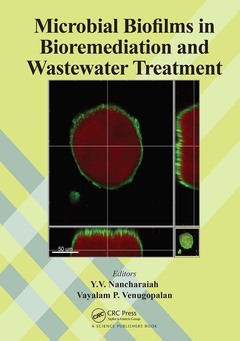Description
Microbial Biofilms in Bioremediation and Wastewater Treatment
Coordinators: Nancharaiah Y.V., Venugopalan Vayalam P.
Language: English
Subjects for Microbial Biofilms in Bioremediation and Wastewater...:
Keywords
Aerobic Granulation; Aerobic Granular Sludge; Aerobic granular sludge biofilms; Granular Sludge; Biodegradation; Synthetic Textile Wastewater; Bioelectrochemical systems; UASB Reactor; Biofilm structure; EPS Molecule; Biomineralization; EPS Structure; Metal bioremediation; Anaerobic Granular Sludge; Sewage treatment; EPS Extract; Waste Biorefinery; MBfR; microbial communities; EPS Content; biofilm mediated bioremediation; EPS Matrix; sustainable development; EPS Component; wastewater treatment; Decolourization Efficiency; EPS Production; Biofilm Reactor; SBR Operation; Biofilm Formation; Cell Surface Hydrophobicity; Real Textile Wastewater; Math Test; Cycle Time; Cod Removal; Textile Wastewater; Dye Bath Effluents
Publication date: 06-2021
· 17.8x25.4 cm · Paperback
Publication date: 10-2019
· 17.8x25.4 cm · Hardback
Description
/li>Contents
/li>Biography
/li>
Biofilms represent the natural living style of microbial communities and play a pivotal role in biogeochemical cycles and natural attenuation. Biofilms can be engineered for biodegradation and biotransformation of organic and inorganic contaminants, for both in situ bioremediation and ex situ treatment in bioreactors. This book focuses on microbial biofilms and their potential technological applications for sustainable development. It covers recent advances in biofilm technologies for contaminant remediation coupled to recovery of resources and serves as a complete reference on the science and technology behind biofilm mediated bioremediation and wastewater treatment.
Biofilms in Oil Bioremediation: Advances and Challenges. Aerobic Granulation Technology for Wastewater Treatment. The EPS Matrix of Aerobic Granular Sludge. Biofilm and Granular Sludge Bioreactors for Textile Wastewater Treatment. Selenium Remediation using Granular and Biofilm Systems. Role of Extracellular Polymeric Substances (EPS) in Cell Surface Hydrophobicity. Removal of Pharmaceuticals from Wastewater by Membrane and Biofilm Reactors. Bioremediation Approaches for Persistent Organic Pollutants Using Microbial Biofilms. Bioprocesses for the Treatment of Volatile Organic Compounds. Bio- and Phytoremediation of Persistent Organic Pollutants in Stormwater Containment Systems and Soil. Emerging Trends in Bioremediation of Explosive Industry Wastewater. Electrocatalytic Biofilm (ECB): Functional Role in Energy and Product Valorization. Titania Nanoparticles Biofilm Formation in Environment Bacteria: A Possible Defense Mechanism.
Y.V. Nancharaiah
After obtaining Master of Science in Biochemistry from Andhra University, Dr. Y.V. Nancharaiah joined Bhabha Atomic Research Centre (BARC) training school in 1994. After completion of one year training, he joined BARC at Kalpakkam in 1995. In the beginning, his work was focussed on biofouling in cooling water systems and cellular level toxicity of chlorine on marine microalgae. He obtained PhD on Aerobic Granular Sludge for Environmental Biotechnology Applications. Currently, he is a Scientific Officer G at BARC, Kalpakkam. His main research interests are in the field of environmental biotechnology, specifically in the fields of bioremediation, biological wastewater treatment and biofouling control. He received Indo-US research Fellow, American Society for Microbiology (ASM) Research Professorship, Marie Curie Experienced Researcher Award and DAE Homi Bhabha Science & Technology Award.
Vayalam P. VenugopalanAfter obtaining his post-graduate degree in marine biology from the Cochin University of Science and Technology, Dr. Vayalam P. Venugopalan joined the National Institute of Oceanography, Goa in 1982. After completing his PhD on biofouling of offshore oil platforms in the Bombay High region of the Arabian Sea, he joined the Bhabha Atomic Research Centre (BARC) at Kalpakkam in 1989. Here, his work was focused on biofouling, biofilms (ecology and biotechnology) and environmental effects of cooling water discharges. He moved to BARC, Mumbai in 2016, where he is currently the Associate Director of the Bioscience Group. He has made significant contributions in the area of biofilm-based processes for wastewater treatment. Since 1996, he is on the editorial boards of Aquatic Ecology (as Consulting Editor) and Water Research (as Associate Editor).
These books may interest you

Biofilms in Plant and Soil Health 216.77 €



